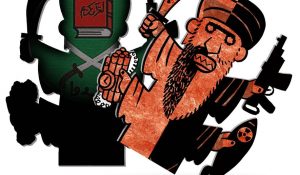The Islamic State is trying to buck up terrorist followers with a glowing report on killings around the globe as its home base “caliphate” in Iraq and Syria continues to crumble, like reported by washingtontimes.com.
In its latest edition, the glossy online magazine Rumiyah, Islamic State’s flagship media production, ignores the shrinking base and focuses instead on the “massacring” the terrorist group is still able to foment.
“As the soldiers of the [caliphate] continue waging war on the forces or kufr [nonbelievers], we take a glimpse at a number of recent operations conducted by the mujahedeen of the Islamic State that have succeeded in expanding the territory of the [caliphate] or terrorizing, massacring and humiliating the enemies of Allah,” the magazine states.
The propaganda goes on to list what it calls successful attacks, including the Aug. 17 carnage in Barcelona, Spain, and more obscure but deadly operations. These include such targets as the Taliban and allies in Afghanistan and the Philippine military.
“These operations are merely a selection of the numerous operations that the Islamic State has conducted on various fronts across many regions over the course of the last few weeks,” says Rumiyah.
Launched last year, the magazine is published in various languages, including English, French and German, with the aim of attracting recruits from the U.S., Europe and elsewhere. Rumiyah is putting its best face on a deteriorating situation that has stanched the flow of fighters.
Although Rumiyah does not tell its readers, Islamic State is losing its main selling point: a self-governing caliphate.
The one-of-a-kind terrorist army has been vanquished from its Iraqi capital of Mosul and has lost the key towns of Ramadi, Fallujah and, most recently, Tal Afar. In Syria, Arab and Kurdish forces, backed by U.S. and allied air power and special operations forces, have taken a majority of the neighborhoods in Raqqa, Syria, Islamic State’s proclaimed capital. Russian-backed Syrian government forces also have recaptured large swaths of territory from the terrorist group.
As a result, much of Islamic State’s current propaganda focuses on conflicts far from its onetime Middle East stronghold.
“Lots of their propaganda content is dealing with Philippines and other territory and activity like in Afghanistan-Pakistan,” said Steven Stalinsky, who directs the Middle East Media Research Institute (MEMRI), which tracks jihadi media. “Also, they are still putting out content including life-as-usual [pieces] in the caliphate. Many of their known media groups and followers on social media are expressing that they are still winning.”
Trying to inspire attacks
Even as it loses its grip on a swath of Iraq and Syria, Islamic State is still able to conduct and inspire mass-casualty attacks.
Rumiyah editors hope that that track record is sufficient to persuade followers globally to keep killing.
The headline “Military and Covert Operations” lauds the cell in Catalonia, which executed two deadly operations on a tourist-packed Barcelona street and in the nearby Spanish town of Cambrils.
“On [Aug. 17], two covert units comprised of several mujahedeen set out in a coordinated manner and targeted the gatherings of the crusaders in Spain,” the article says. “The blessed raid resulted in the killings and wounding of at least 146 citizens of the crusader coalition.”
Spanish officials put the number of victims at a fraction of the number claimed by the Islamic State propaganda organ.
In Afghanistan, Rumiyah claims that a burgeoning Islamic State has attacked the Taliban and allies and repelled counterassaults by the Afghan army. A follower assassinated a Pakistani intelligence operative, and another detonated a vehicle bomb that killed Pakistani soldiers.
The magazine claims successful strikes in July and August in the Philippines, Tunisia, Yemen, Somalia, Egyptian Sinai, Iraq, Syria, Lebanon and Russia.
Rumiyah makes dubious claims to back up its case, even listing an attack on an Iraqi army barracks that, rather than happening recently, occurred more than a year ago. Likewise, the intelligence officer was gunned down in 2016.
Then there is the pivotal Iraqi town of Tal Afar, a crossroads between Mosul and the Syrian border.
Rumiyah depicts Islamic State militants waging a heroic battle to keep the city first seized from Iraqi government control in June 2014.
“The soldiers of the [caliphate] for the second consecutive day repelled a crusader and Rafidi [caliphate rejectors] campaign against the city of Tal Afar, whose western and eastern axes witnessed fierce fighting,” the magazine said.
In reality, the city fell to the coalition in August.
“We are seeing steady progress and overwhelming momentum in the fight to defeat ISIS in Iraq,” U.S. Army Col. Ryan S. Dillon, a command spokesman in Baghdad, told reporters on Sept. 7, using an acronym for the Islamic State. “Iraqi security forces rolled over ISIS in decisive operations in Tal Afar. The [Iraqi Security Forces] are now quickly transitioning for follow-on operations in the few remaining ISIS-held areas in Iraq.”
He added, “We are witnessing the continued degradation of a morally bankrupt terrorist fighting force whose leaders are detaching more and more often from their foot soldiers.”



